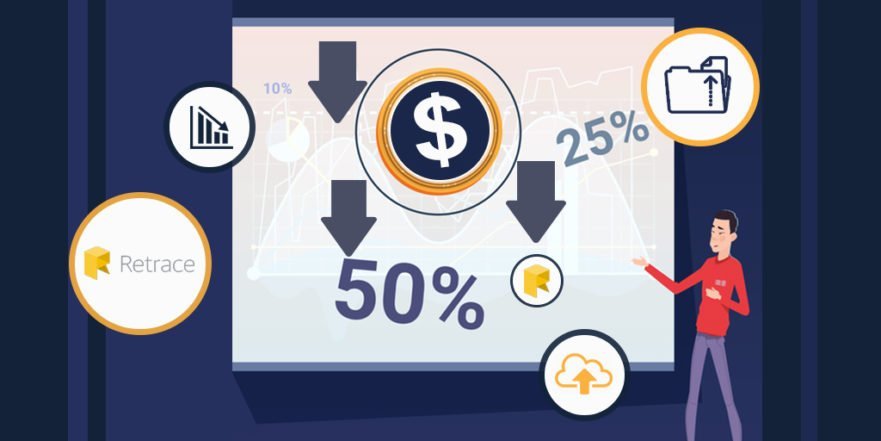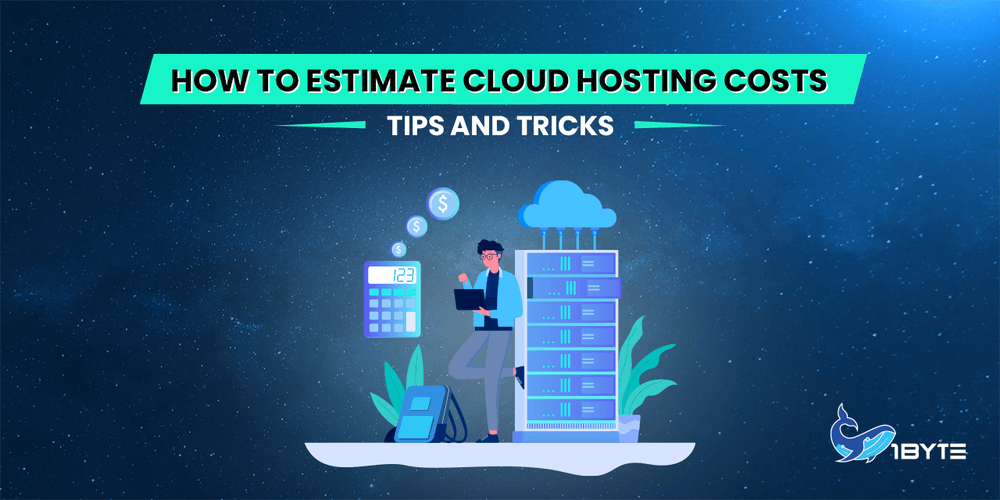Cloud hosting is becoming increasingly popular in today’s digital age due to its scalability, flexibility, and cost-effectiveness. However, evaluating cloud hosting expenses can be difficult for individuals unfamiliar with the technology. In this article, we’ll go over five tips and strategies to guide you on how to estimate cloud hosting costs and avoid surprises later on. We will also equip you with the resources you need to make informed decisions regarding your cloud hosting needs, whether you’re a small business owner or an IT specialist.
An Overview
Because of its multiple advantages, cloud hosting has grown in popularity in recent years. Cloud hosting allows organizations to scale their resources up or down, pay only for what they use, and decrease capital costs. However, with all of these benefits come obstacles, particularly when considering cloud hosting costs. In this section, we will provide you an overview of cloud hosting, and what you should know before estimating its expenses.
What is Cloud Hosting?
The term “cloud hosting” refers to a type of hosting in which websites or apps are stored on virtual servers that draw their resources from a network of real servers. Cloud hosting allows businesses to host their websites or applications in a flexible, scalable, and cost-effective manner. Cloud hosting, unlike traditional hosting, does not rely on a single physical server to host a website or application. Instead, it distributes resources and handles traffic through a network of servers. This means that if one server fails, the rest of the network’s servers can step in and supply backup resources.
Infrastructure as a Service (IaaS), Platform as a Service (PaaS), and Software as a Service (SaaS) are the three categories of services commonly provided by cloud hosting providers. IaaS gives access to virtual servers, storage, and other computing resources to enterprises, whereas PaaS provides a platform for developing and deploying applications. SaaS gives organizations online access to software applications, reducing the need to install and maintain software locally.
The Current State of Cloud Hosting
Cloud hosting has grown in popularity in recent years, and its current status reflects this tendency. According to current statistics, the global cloud hosting market was worth USD 483.98 billion in 2022 and is predicted to have a 14.1% CAGR from 2023 to 2030. The benefits of cloud hosting, such as scalability, flexibility, and cost-effectiveness, can be linked to this increase. Cloud hosting is being used by many businesses to better their operations, and this trend is projected to grow in the future years.
Scalability is one of the primary benefits of cloud hosting. Cloud hosting enables organizations to effortlessly scale up or down their resources as needed, allowing them to adapt swiftly to changes in demand. This makes it a great solution for firms with varying resource needs since it prevents over- or under-provisioning of resources, which may be costly.

Cloud hosting provides flexibility in addition to scalability. Businesses can use cloud hosting to select the resources they require and only pay for what they use. This means that organizations can adapt their hosting solutions to match their individual requirements while avoiding paying for resources that aren’t required.
Finally, cloud hosting might be an affordable option for organizations. Traditional hosting options often require organizations to invest in costly hardware and software, as well as pay for ongoing maintenance and upgrades. These costs are often handled by the hosting provider with cloud hosting, allowing organizations to save money on infrastructure costs.
Overall, cloud hosting is experiencing growth and innovation. As more businesses turn to cloud hosting to improve their operations, cloud technology will continue to progress, with an increased emphasis on scalability, adaptability, and cost-effectiveness.
The Importance of Estimating Cloud Hosting Costs
Cloud hosting has grown in popularity in recent years due to its flexibility, scalability, and low cost. However, it is critical to precisely estimate the cost of cloud hosting in order to prevent overspending and get the most bang for your buck.
Estimating cloud hosting costs is critical since it allows you to efficiently plan and budget, avoid unexpected charges, and optimize your cloud infrastructure for optimal efficiency. You can make informed judgments about which cloud services to utilize and how to arrange them to fit your individual needs by analyzing cloud hosting expenses. Overprovisioning can occur from underestimating your cloud hosting prices, resulting in lost resources and excessive expenses. Furthermore, failing to estimate your cloud hosting costs might lead to an underestimation of your actual costs, resulting in unanticipated charges and budget overruns. As a result, it is critical to precisely and periodically estimate your cloud hosting expenses to ensure that you are getting the most out of your investment.
To estimate your cloud hosting expenses, evaluate your consumption patterns, the sort of services you require, and the size of your infrastructure. You should also analyze your consumption on a regular basis and alter your configuration as needed to reduce expenditures. You may prevent wasting resources and ensure that you only pay for the services you require by doing so. In addition to monitoring your usage, you should make use of your cloud provider’s cost estimation tools and services. These tools can assist you in more accurately estimating your costs and provide advice for optimizing your infrastructure to further minimize your costs.
Recommended reading: VPS Hosting vs Cloud Hosting: Which Is the Right Choice for Your Business?
Cloud Hosting Cost Models
Cloud hosting cost models are a crucial aspect of estimating cloud hosting costs. Different cloud hosting providers offer various pricing models, making it challenging to understand which model would best fit your organization’s needs. In this section, we’ll discuss the different cloud hosting cost models and their benefits and drawbacks, so you can choose the most cost-effective one for your business. Understanding the different cost models available can help you make an informed decision and avoid unexpected charges. Let’s explore the various cloud hosting cost models available and how they could impact your cloud hosting expenses.
Pay-as-you-go pricing
Pay-as-you-go pricing is a billing model in which clients are charged based on their use of cloud services. It’s the same as buying gas for your car: you only pay for what you use. This means you only pay for the resources you require when you require them, with no upfront payments required. Pay-as-you-go pricing is popular because it is flexible and allows firms to scale up or down their resources as needed without incurring any extra expenditures.
You may simply predict your cloud hosting expenses with pay-as-you-go pricing by tracking your resource utilization. For example, if you know you’ll need a particular amount of storage, bandwidth, and computing power, you may use the pay-as-you-go pricing model to predict how much it will cost you. Furthermore, many cloud providers give cost calculators and management tools to assist you in more properly estimating your costs.
It’s important to remember that, while pay-as-you-go pricing can save money for some firms, it may not be the ideal solution for everyone. Other pricing methods, like reserved instances or spot instances, may benefit businesses with steady and predictable resource utilization. Pay-as-you-go pricing, on the other hand, can help firms with fluctuating workloads save costs and optimize resource consumption.
Reserved instances
Reserved instances are a cloud provider pricing approach that can help organizations save money on cloud hosting costs. Reserved instances, in essence, allow organizations to pay for cloud resources in advance and obtain a large discount on their utilization over time. This is an excellent option for organizations that use consistent and predictable resources because it can help them save money in the long run.
Businesses can use reserved instances to reserve a specified amount of computing power, storage, and bandwidth for a set length of time, such as one or three years. In exchange for this commitment, they will receive a 75% discount on their consumption during the reservation time. This can result in significant cost savings over time, particularly for organizations with steady workloads.

It should be noted that reserved instances are not as adaptable as pay-as-you-go pricing. Businesses must commit to a set number of resources for a set length of time, and they may suffer additional expenses if they need to use more resources than they have reserved. Reserved instances, on the other hand, can provide significant cost savings and predictability for enterprises with predictable resource demand.
To determine your cloud hosting costs utilizing reserved instances, calculate your resource utilization over time and compare it to the expenses of reserving the same number of resources upfront. This may necessitate some forecasting and preparation, but it may be worthwhile for organizations with predictable workloads.
Spot instances
Spot instances are another cost-cutting alternative for enterprises when assessing their cloud hosting expenditures. Cloud providers offer these instances at a substantially cheaper cost than their on-demand instances, but there is a catch: the price of spot instances might fluctuate depending on availability and demand.
Spot instances function by cloud providers offering unused capacity to enterprises at a reduced price. However, when demand for computer resources rises, the price of spot instances may grow as well. If the price of spot instances exceeds what enterprises are prepared to pay, their spots will be cancelled and their workloads will be disrupted.
Despite this danger, spot instances can be an excellent solution for businesses to reduce cloud hosting expenses, particularly for non-critical applications that can accept interruptions. When compared to on-demand instances, spot instances can save up to 90% of the cost.
To estimate your cloud hosting expenses utilizing spot instances, you must monitor spot instance pricing and forecast when the cost of using them will be lower than the cost of using on-demand instances. You may also use automated tools to manage your spot instances and avoid downtime.
Dedicated instances
Dedicated instances are specialized cloud hosting instances that can be utilized to improve performance and security. Businesses have complete control over the underlying hardware that their workloads operate on with dedicated instances, which can provide better performance and security than other instance types.
Dedicated instances, unlike other instance types, are not shared with other customers. This means that organizations can have more predictable performance and ensure that their workloads are not influenced by the workloads of other customers.
Dedicated instances, on the other hand, are often more expensive than other instance types because businesses are paying for exclusive usage of the underlying hardware. Dedicated instances can be up to 15% more expensive than on-demand instances, according to some estimates.
Businesses should carefully examine their performance and security requirements when determining cloud hosting expenses utilizing dedicated instances. If these factors are significant, the increased cost of dedicated instances may be justified. If performance and security are not high requirements, different instance types may offer adequate performance at a reduced cost.
Recommended reading: 5 Benefits of Cloud Hosting for Your Business
5 Tips and Tricks to Estimate Cloud Hosting Costs
Estimating cloud hosting expenses can be difficult, especially for people unfamiliar with the cloud environment. With so many pricing models, services, and variables to consider, it’s easy to become disoriented and end up with a surprise cost. This section will give you 5 ideas and strategies for estimating cloud hosting expenses accurately. Whether you’re contemplating a cloud migration or optimizing your present cloud infrastructure, these suggestions can help you make educated decisions while keeping expenses under control. So, let’s get this party started!
Start with a pilot project
If you’re unsure about the price of cloud hosting, a pilot project is an excellent place to start. A pilot project is a small-scale trial that allows you to test the waters before making a full-scale commitment.
Pilot projects are especially beneficial for cloud hosting since they allow you to predict expenses based on actual usage, which is far more accurate than projections or estimates. Starting small allows you to evaluate the usage and costs of your cloud hosting setup and make changes as needed.
It is critical to identify your goals and scope while preparing your pilot project. Determine appropriate applications or workloads to test and the expected usage patterns. This will assist you in developing a more realistic cost estimate for your pilot project.
Keep a tight check on the price and utilization of your cloud hosting environment during your pilot project. Use monitoring technologies to track resource utilization and uncover cost-cutting opportunities. For instance, if you observe that a specific job is consuming more resources than intended, you may be able to optimize it to save money.
When your pilot project is finished, you can utilize the data you gathered to provide a more accurate cost estimate for your full-scale rollout. Starting with a pilot project will provide you with a better idea of the costs involved with cloud hosting and will enable you to make more educated decisions regarding your deployment.
Choose the right cloud provider
As a premier cloud computing firm, 1Byte understands the importance of selecting the correct cloud provider for your company’s needs. When evaluating your cloud hosting costs, it’s critical to select a provider that provides the appropriate services and price for your workload. Some cloud providers give a large range of services that you may not require, whilst others may lack the functionality you desire.

Before choosing a service, you should understand what you require and do not require from a cloud provider. For example, if you’re looking for a provider who specializes in data analysis, make sure they have the required equipment and skills to manage your needs. It is also critical to analyze the provider’s price structure. Some service providers charge based on usage, while others charge a set monthly rate.
It is critical to conduct research and select a provider who meets your company’s specific requirements. Don’t just go with the biggest or most well-known supplier; they may not be the best fit for you. Before making a purchase, evaluate cost, services, and support options.
Use cost estimation tools
Using cost estimation tools to estimate cloud hosting costs can be a game changer. These tools can assist you in calculating costs in a more precise and timely manner than manual techniques. To estimate the expenses of using various platforms, 1Byte recommends using cost estimating tools such as AWS Simple Monthly Calculator or Azure Pricing Calculator. These tools can assist you in developing a more realistic estimate of the costs connected with your cloud hosting project.
Using these tools is simple; simply enter your desired requirements (such as the amount of storage, computing power, and data transfer necessary), and the tool will offer an estimate of your expenditures. These tools also allow you to compare costs across multiple cloud providers, which might be useful if you’re still deciding on a provider.
Furthermore, some cloud providers, such as Google Cloud Platform’s pricing calculator, provide their own cost calculation tools. If you want to use that specific cloud provider, employing these tools can help you get a more accurate estimate of your expenditures.
Keep in mind that, while these tools can be useful, they are not perfect. Actual prices may differ depending on consumption trends, application design, and other variables. As a result, it’s critical to keep track of your usage and change your estimates as needed.
Monitor usage and adjust accordingly
Using cost estimation tools to estimate cloud hosting costs can be a game changer. These tools can assist you in calculating costs in a more precise and timely manner than manual techniques. To estimate the expenses of using various platforms, 1Byte recommends using cost estimating tools such as AWS Simple Monthly Calculator or Azure Pricing Calculator. These tools can assist you in developing a more realistic estimate of the costs connected with your cloud hosting project.
Using these tools is simple; simply enter your desired requirements (such as the amount of storage, computing power, and data transfer necessary), and the tool will offer an estimate of your expenditures. These tools also allow you to compare costs across multiple cloud providers, which might be useful if you’re still deciding on a provider.
Furthermore, some cloud providers, such as Google Cloud Platform’s pricing calculator, provide their own cost calculation tools. If you want to use that specific cloud provider, employing these tools can help you get a more accurate estimate of your expenditures.
Keep in mind that, while these tools can be useful, they are not perfect. Actual prices may differ depending on consumption trends, application design, and other variables. As a result, it’s critical to keep track of your usage and change your estimates as needed.
Look for cost optimization opportunities
Looking for cost-cutting opportunities is an important step in estimating and managing cloud hosting costs. Cloud hosting providers typically provide a variety of price alternatives, and you must choose the best fit for your organization’s requirements. For example, you may use reserved instances, which are a low-cost solution for predictable workloads. Spot instances, on the other hand, offer large discounts for underutilized cloud capacity. You can also use auto-scaling and load balancing tools to optimize resource utilization and cut costs. You may automatically increase or decrease the resources needed by your application based on demand by using these technologies. It ensures that you are using the appropriate amount of resources and that you only pay for what you use=.
Furthermore, it is critical to periodically monitor and evaluate your cloud usage statistics in order to uncover cost-cutting alternatives. This information can assist you in identifying trends, expense drivers, and potential cost-cutting possibilities. For example, you may discover that particular apps or services are not or are being underutilized. In this situation, you should think about canceling or consolidating them to save money. You can also monitor your cloud consumption trends to determine peak usage hours and change your resources accordingly. You can prevent the extra expenditures associated with over-provisioning resources by doing so.
Conclusion
Evaluating cloud hosting prices is critical for keeping your cloud infrastructure costs under control. You may obtain a better understanding of how much your cloud hosting will cost and how to optimize it by following these five steps. Remember to use cost estimation tools, monitor consumption and adapt accordingly, search for cost optimization opportunities, and review and update your cloud hosting cost projections on a regular basis. This way, you can verify that you’re getting the most bang for your buck and prevent unforeseen costs.
With cloud hosting growing more popular, it’s critical to have a firm grasp on how to estimate cloud hosting expenses. So, take the time to implement these suggestions, and you’ll be well on your way to better managing your cloud hosting costs.

